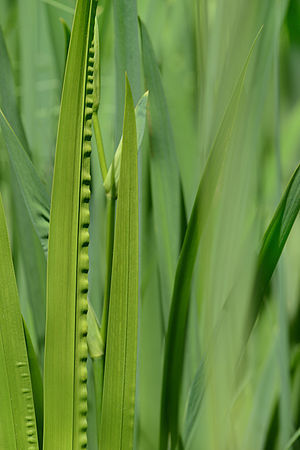Note: This is a project under development. The articles on this wiki are just being initiated and broadly incomplete. You can Help creating new pages.
Phragmites communis
Phragmites communis is a genus of four species of large perennial grasses found in wetlands throughout temperate and tropical regions of the world. The World Checklist of Selected Plant Families, maintained by Kew Garden in London.
Contents
[hide]- 1 Uses
- 2 Parts Used
- 3 Chemical Composition
- 4 Common names
- 5 Properties
- 6 Habit
- 7 Identification
- 8 List of Ayurvedic medicine in which the herb is used
- 9 Where to get the saplings
- 10 Mode of Propagation
- 11 How to plant/cultivate
- 12 Commonly seen growing in areas
- 13 Photo Gallery
- 14 References
- 15 External Links
Uses
Parts Used
Chemical Composition
2,3-dihydroxy-1-(4-hydroxy-3,5-dimethoxyphenyl)-1-propanone, ferulic acid, p-coumaric acid, syringic acid, vanillic acid , p-hydroxy benzoic acid, p-hydroxybenzaldenhyde, palmitic acid, heptadecanoic acid, β-sitosterol, stigmasterol, α-D-glucose and β-D-glucose.[1]
Common names
| Language | Common name |
|---|---|
| Kannada | |
| Hindi | |
| Malayalam | |
| Tamil | |
| Telugu | |
| Marathi | NA |
| Gujarathi | NA |
| Punjabi | NA |
| Kashmiri | NA |
| Sanskrit | |
| English | Common reed, Giant reed |
Properties
Reference: Dravya - Substance, Rasa - Taste, Guna - Qualities, Veerya - Potency, Vipaka - Post-digesion effect, Karma - Pharmacological activity, Prabhava - Therepeutics.
Dravya
Rasa
Guna
Veerya
Vipaka
Karma
Prabhava
Habit
Identification
Leaf
| Kind | Shape | Feature |
|---|---|---|
| Simple | Long | 20–50 centimetres (7.9–19.7 in) and 2–3 centimetres (0.79–1.18 in) broad |
Flower
| Type | Size | Color and composition | Stamen | More information |
|---|---|---|---|---|
| Dark purple panicle | About 20–50 cm long. |
Other features
List of Ayurvedic medicine in which the herb is used
Where to get the saplings
Mode of Propagation
How to plant/cultivate
Common reed is found in most areas of the world from the cold temperate zone to the tropics. It grows best in areas where annual daytime temperatures are within the range 30 - 35°c, but can tolerate 7 - 40°c. Dormant plants are hardy to about -20°c.[3]
Commonly seen growing in areas
Photo Gallery
References
External Links
- Ayurvedic Herbs known to be helpful to treat Bronchitis
- Ayurvedic Herbs known to be helpful to treat Cholera
- Herbs with Flower used in medicine
- Herbs with Leaves used in medicine
- Herbs with Roots used in medicine
- Herbs with common name in English
- Habit - Herbs
- Index of Plants which can be propagated by Seeds
- Herbs that are commonly seen in the region of Grass Land
- Herbs
- Poaceae



